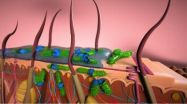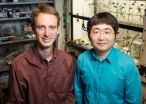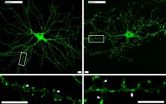(Press-News.org) WHAT:
A laboratory study led by scientists from the National Institute of Allergy and Infectious Diseases, part of the National Institutes of Health (NIH), lends further weight to the potential effectiveness of passive immunotherapy to suppress HIV in the absence of drug treatment. Passive immunotherapy for HIV is an experimental strategy that involves periodically administering broadly neutralizing HIV-specific antibodies (bNAbs) to control the virus. It would be advantageous to control HIV without antiretroviral drugs because of their cost, the potential for cumulative toxicities from lifelong therapy, and the difficulties some patients have adhering to drug regimens and tolerating certain drugs.
Although bNAbs have proven effective at blocking infection by various strains of HIV in the laboratory, their effect on HIV in humans, and particularly on the virus particles that hide in immune cells (called latent viral reservoirs), has been unknown.
In this study, NIH scientists obtained HIV from the latent reservoirs of 29 infected people in whom antiretroviral therapy fully inhibited viral replication. In the laboratory, the researchers found that several bNAbs—particularly PGT121, VRC01 and VRC03 —effectively blocked HIV from entering the CD4+ T cells obtained from uninfected healthy donors. In addition, the scientists demonstrated in the laboratory that these antibodies could completely block HIV replication in CD4+ T cells obtained from infected individuals receiving antiretroviral therapy.
The researchers conclude that passive immunotherapy involving bNAbs individually or in combination may control HIV in the absence of antiretroviral therapy. A number of clinical trials are already underway or planned to test this hypothesis.
INFORMATION:
ARTICLE:
T-W Chun, et al. Broadly neutralizing antibodies suppress HIV in the persistent viral reservoir. PNAS DOI: 10.1073/pnas.1414148111 (2014).
WHO:
NIAID Director Anthony S. Fauci, M.D., and Tae-Wook Chun, Ph.D., staff scientist in the NIAID Laboratory of Immunoregulation, are available for comment.
CONTACT:
To schedule interviews, please contact Laura S. Leifman, (301) 402-1663, laura.sivitz@nih.gov.
NIAID conducts and supports research—at NIH, throughout the United States, and worldwide—to study the causes of infectious and immune-mediated diseases, and to develop better means of preventing, diagnosing and treating these illnesses. News releases, fact sheets and other NIAID-related materials are available on the NIAID Web site at http://www.niaid.nih.gov.
About the National Institutes of Health (NIH): NIH, the nation's medical research agency, includes 27 Institutes and Centers and is a component of the U.S. Department of Health and Human Services. NIH is the primary federal agency conducting and supporting basic, clinical, and translational medical research, and is investigating the causes, treatments, and cures for both common and rare diseases. For more information about NIH and its programs, visit http://www.nih.gov/.
NIH...Turning Discovery Into Health
HIV antibodies block infection by reservoir-derived virus in laboratory study
NIH-led team finds strategy to achieve sustained HIV remission promising
2014-08-26
ELSE PRESS RELEASES FROM THIS DATE:
Breakthrough antibacterial approach could resolve serious skin infections
2014-08-26
Like a protective tent over a colony of harmful bacteria, biofilms make the treatment of skin infections especially difficult. Microorganisms protected in a biofilm pose a significant health risk due to their antibiotic resistance and recalcitrance to treatment, and biofilm-protected bacteria account for some 80 percent of total bacterial infections in humans and are 50 to 1,000 times more resistant to antibiotics than simpler bacterial infections.
"In essence, we may have stumbled onto a magic bullet," said David Fox, a Los Alamos National Laboratory researcher on the ...
Scientists craft atomically seamless, thinnest-possible semiconductor junctions
2014-08-26
Scientists have developed what they believe is the thinnest-possible semiconductor, a new class of nanoscale materials made in sheets only three atoms thick.
The University of Washington researchers have demonstrated that two of these single-layer semiconductor materials can be connected in an atomically seamless fashion known as a heterojunction. This result could be the basis for next-generation flexible and transparent computing, better light-emitting diodes, or LEDs, and solar technologies.
"Heterojunctions are fundamental elements of electronic and photonic devices," ...
Personal protective equipment is critical but not enough to shield health care workers from Ebola
2014-08-26
Personal protective equipment is critical but not enough to shield health care workers from Ebola*
Free content
Personal protective equipment designed to shield health care workers from contaminated body fluids of Ebola patients is not enough to prevent transmission, according to a commentary being published early online today in Annals of Internal Medicine. Despite the known effectiveness of barrier protection in blocking Ebola transmission, infections among health care workers have played a major role in outbreaks. William A. Fischer II, MD from the University of North ...
Challenges ahead in improving child health by increasing access to sanitation in India
2014-08-26
A study published in this week's PLOS Medicine on large-scale rural sanitation programs in India highlights challenges in achieving sufficient access to latrines and reduction in open defecation to yield significant health benefits for young children.
The researchers, led by Sumeet Patil from the School of Public Health, University of California at Berkeley, and the Network for Engineering and Economics Research and Management in Mumbai, India conducted a cluster randomised controlled trial in 80 rural villages in the Indian state of Madhya Pradesh to measure the effect ...
A glucose meter of a different color provides continuous monitoring
2014-08-26
CHAMPAIGN, Ill. — University of Illinois engineers are bringing a touch of color to glucose monitoring.
The researchers developed a new continuous glucose monitoring material that changes color as glucose levels fluctuate, and the wavelength shift is so precise that doctors and patients may be able to use it for automatic insulin dosing - something not possible using current point measurements like test strips.
"There are significant limitations to current continuous glucose monitoring technologies," said study leader Paul Braun, a professor of materials science and ...
NASA's TRMM and Aqua satellites gaze into Hurricane Cristobal
2014-08-26
NASA's TRMM and Aqua satellites have been providing views of the outside and inside of Hurricane Cristobal as it heads for Bermuda. The National Hurricane Center posted a Tropical Storm Watch for Bermuda as Cristobal heads in that direction.
Strong winds and flooding associated with Tropical Storm Cristobal caused deaths in the Dominican Republic, Haiti, and Jamaica. The Tropical Rainfall Measuring Mission or TRMM satellite captured rainfall data from Cristobal on August 24, 2014 at 1150Z (7:50 a.m. EDT). Light to moderate rainfall was occurring throughout much of the ...
Satellite shows Hurricane Marie about to swallow Karina
2014-08-26
Massive Hurricane Marie appears like a giant fish about to swallow tiny Tropical Depression Karina on satellite imagery today from NOAA's GOES-West satellite. Karina, now a tropical depression is being swept into Marie's circulation where it is expected to be eaten, or absorbed.
An image from NOAA's GOES-West satellite on Aug. 26 at 8 a.m. EDT shows Karina being drawn into the powerful and large circulation of Hurricane Marie to the east of the depression. The image was created by NASA/NOAA's GOES Project at NASA's Goddard Space Flight Center in Greenbelt, Maryland.
Forecasters ...
NASA sees huge Hurricane Marie slam Socorro Island
2014-08-26
NASA's Terra satellite passed over Hurricane Marie when its eye was just to the west of Socorro Island in the Eastern Pacific. Marie's eye may have been near the island, but the storm extended several hundreds of miles from there.
On Aug. 25 at 18:20 UTC (2:20 p.m. EDT) the Moderate Resolution Imaging Spectroradiometer or MODIS instrument aboard NASA's Terra satellite captured Hurricane Marie's center just west of Socorro Island. The image showed Marie's tightly wound center and eye. A thick band of powerful thunderstorms surrounded the center of circulation, and bands ...
Lack of naturally occuring protein linked to dementia
2014-08-26
Scientists at the University of Warwick have provided the first evidence that the lack of a naturally occurring protein is linked to early signs of dementia.
Published in Nature Communications, the research found that the absence of the protein MK2/3 promotes structural and physiological changes to cells in the nervous system. These changes were shown to have a significant correlation with early signs of dementia, including restricted learning and memory formation capabilities.
An absence of MK2/3, in spite of the brain cells (neurons) having significant structural ...
Existing power plants will spew 300 billion more tons of carbon dioxide during use
2014-08-26
Irvine, Calif. — Existing power plants around the world will pump out more than 300 billion tons of carbon dioxide over their expected lifetimes, significantly adding to atmospheric levels of the climate-warming gas, according to UC Irvine and Princeton University scientists.
Their findings, which appear Aug. 26 in the journal Environmental Research Letters, are the first to quantify how quickly these "committed" emissions are growing – by about 4 percent per year – as more fossil fuel-burning power plants are built.
Assuming these stations will operate for 40 years, ...
LAST 30 PRESS RELEASES:
What causes some people’s gut microbes to produce high alcohol levels?
Global study reveals widespread burning of plastic for heating and cooking
MIT study shows pills that communicate from the stomach could improve medication adherence
Searching for the centromere: diversity in pathways key for cell division
Behind nature’s blueprints
Researchers search for why some people’s gut microbes produce high alcohol levels
Researchers find promising new way to boost the immune response to cancer
Coffee as a staining agent substitute in electron microscopy
Revealing the diversity of olfactory receptors in hagfish and its implications for early vertebrate evolution
Development of an ultrasonic sensor capable of cuffless, non-invasive blood pressure measurement
Longer treatment with medications for opioid use disorder is associated with greater probability of survival
Strategy over morality can help conservation campaigns reduce ivory demand, research shows
Rising temperatures reshape microbial carbon cycling during animal carcass decomposition in water
Achieving ultra-low-power explosive jumps via locust bio-hybrid muscle actuators
Plant-derived phenolic acids revive the power of tetracycline against drug-resistant bacteria
Cooperation: A costly affair in bacterial social behaviour?
Viruses in wastewater: Silent drivers of pollution removal and antibiotic resistance
Sub-iethal water disinfection may accelerate the spread of antibiotic resistance
Three in four new Australian moms struggle with body image
Post-stroke injection protects the brain in preclinical study
Cardiovascular risk score predicts multiple eye diseases
Health: estimated one in ten British adults used or interested in GLP-1 medications for weight loss
Exercise to treat depression yields similar results to therapy
Whooping cough vaccination for pregnant women strengthens babies’ immune system
Dramatic decline in new cases of orphanhood in Uganda driven by HIV treatment and prevention programs
Stopping weight loss drugs linked to weight regain and reversal of heart health markers
Higher intake of food preservatives linked to increased cancer risk
Mass General Brigham–developed cholera vaccine completes phase 1 trial
First experimental validation of a “150-year-old chemical common sense” direct visualization of the molecular structural changes in the ultrafast anthracene [4+4] photocycloaddition reaction
Lack of support for people on weight loss drugs leaves them vulnerable to nutritional deficiencies, say experts
[Press-News.org] HIV antibodies block infection by reservoir-derived virus in laboratory studyNIH-led team finds strategy to achieve sustained HIV remission promising








